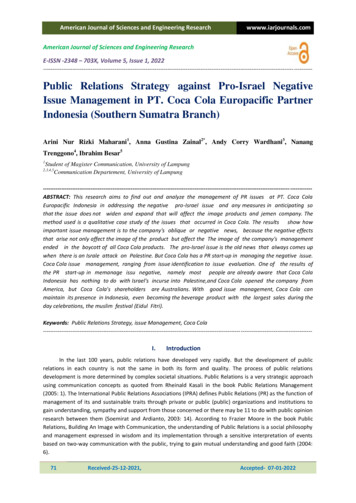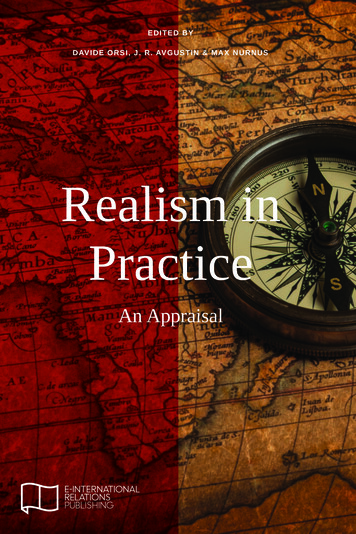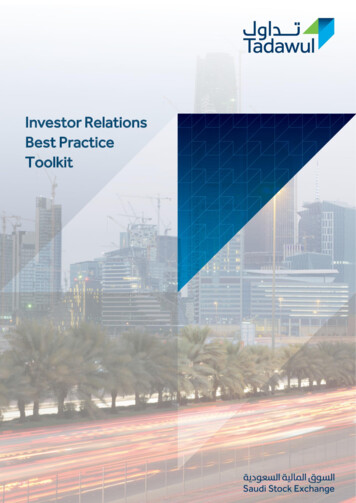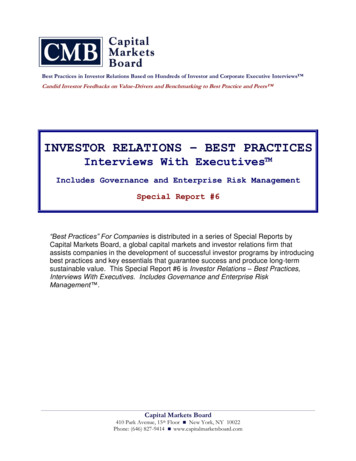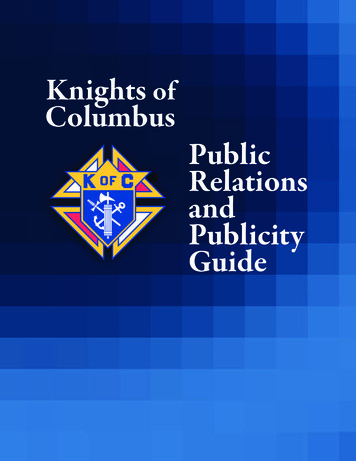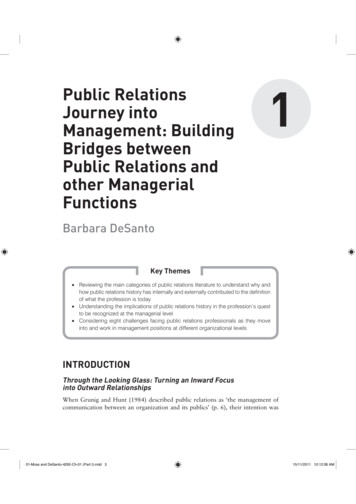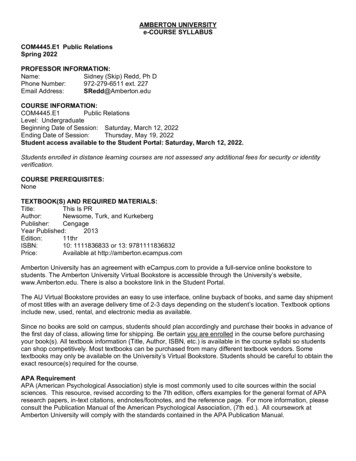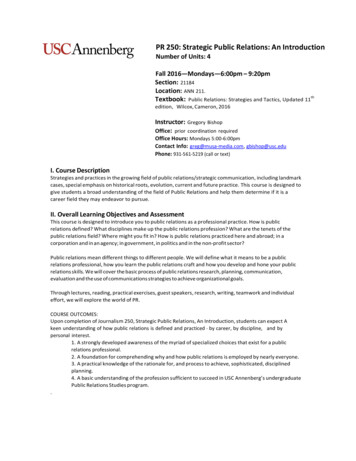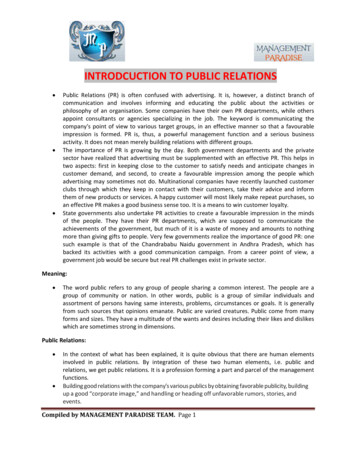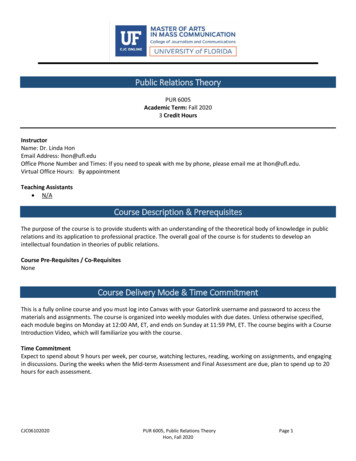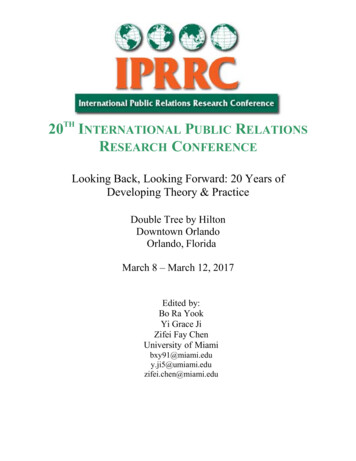
Transcription
20TH INTERNATIONAL PUBLIC RELATIONSRESEARCH CONFERENCELooking Back, Looking Forward: 20 Years ofDeveloping Theory & PracticeDouble Tree by HiltonDowntown OrlandoOrlando, FloridaMarch 8 – March 12, 2017Edited by:Bo Ra YookYi Grace JiZifei Fay ChenUniversity of mi.edu
Board of DirectorsDon W. Stacks, Ph.D., University of Miami, Executive DirectorShannon Bowen, Ph.D., University of South Carolina, DirectorMichelle Hinson, CyberAlert/University of Florida, Chief Financial OfficerDavid Michaelson, Ph.D., Teneo Strategy, DirectorLou Williams, The Lou Williams Companies, DirectorDonald K. Wright, Ph.D., Boston University, DirectorJackie Matthews, General Motors, DirectorRESEARCH CONFERENCE ADVISORY BOARDAli Alanazi, Ph.D., King Saud UniversityW. Timothy Coombs, Ph.D., Texas A&M UniversityMarcia Watson DiStaso, Ph.D., Pennsylvania State UniversityMelissa D. Dodd, Ph.D., University of Central FloridaDavid Dozier, Ph.D. San Diego State UniversityTerry Flynn, Ph.D., McMaster UniversityJohn Gilfeather, Koski Research Inc.Dave Hecht, United States NavyFlora Hung-Baesecke, Ph.D. Massey University, New ZealandDean Kruckeberg, Ph.D., University of North Carolina, CharlotteZongchao Cathy Li, Ph.D., San José State UniversityFraser Likely, Likely Communications StrategiesTina Carroll McCorkindale, Ph.D., Insitute for Public RelationsLinjuan Rita Men, Ph.D., University of FloridaJulie O’Neil, Ph.D., Texas Christian UniversityKatharine D. Paine, Paine PublishingRobert S. Pritchard, University of OklahomaBrad Rawlins, Ph.D., Arkansas State UniversityStacey Smith, Jackson, Jacoson & WagnerDustin Supa, Ph.D., Boston UniversityKaterina Tsetsura, Ph.D., University of OklahomaJudy VanSlyke Turk, Ph.D., Professor Emerita, Virginia Commonwealth UniversitySean Williams, Communication AMMO, Inc.Koichi Yamamura, Ph.D., Media Gain Co., LtdAnsgar Zerfass, Ph.D., University of LeipzigLynn M. Zoch, Ph.D., Radford UniversityPast Conference DirectorsMelvin Sharpe, Ph.D., APR, Fellow PRSAIn Memory:Jack Felton, Institute for Public Relations
2We would like to thank the following for supporting socially beneficial publicrelations research that increases understanding, builds relationships, supports ethical sociallyresponsible performance, and advances the development of an increasingly democratic globalsociety:Corporate SponsorsAPCO WorldwideArthur W. Page SocietyBoston University, College of CommunicationCargillCommunication AMMOCyberAlertEdelman BerlandFleishman HillardGMIBMUniversity of Oklahoma, Gaylord CollegePaine PublishingPublic Relations Society of AmericaTeneoWeber ShandwickWells FargoUSAAPaper Award SponsorsABERJEBoston University, College of CommunicationBrigham Young University, Department of CommunicationsPeter DebrecenyInstitute for Public RelationsJohn W. FeltonJackson, Jackson & WagnerKoichi YamamuraLikely Communication StrategiesUniversity of Miami, School of CommunicationThe Arthur W. Page CenterTexas Tech University, College of Media & Communication
3TABLE OF CONTENTSPolicy Aside: A Framing Study on Influencing Cultural and Policy Change11within an OrganizationKalyca Becktel, Cassandra Gesecki, Justin Smith, and Caleb Eames, San Diego StateUniversityThis study uses the theory of framing to investigate its effect on the public’sperception of the Marine Corps as women prepare to enter combat jobs. Resultsindicate that the framing of gender integration has a significant impact onparticipant perception of the Marine Corps’ reputation, credibility, andcharacteristics.Examining the Business Outcomes of Media Coverage in the General MotorRecall Crisis: An Exploratory Study22Yang Cheng, PRIME ResearchThis study applied the Vector-Auto Regression model to explore the businessimpacts of media coverage in a recall crisis. Findings showed the media agenda,especially traditional media coverage played an important role in predictingbusiness outcomes. Future practitioners may consistently monitor both traditionaland new media coverage in their crisis communication.Businesses Under Close Watch: Examining the Factors That AffectReputation Repair36Koichi Yamamura International Strategic Communication AwardRebecca Marissa Cohen, Jesson & Co, Toronto, CanadaThrough in-depth interviews, content analysis, and survey, results of this studysuggest that reputation management is a top priority amongst Canadianorganizations. Majority of survey participants and interviewees use multiple toolsto monitor and measure reputation. Interview results demonstrated thatcommunications teams had representation at the executive level.Kap Takes a Knee: A Media Framing Analysis of Colin Kaepernick’sAnthem ProtestDanielle Sarver Coombs, Cheryl Ann Lambert, David Cassilo, and ZacharyHumphries, Kent State UniversityMedia frame analysis of Colin Kaepernick’s anthem protest revealed Virality, Powerand Influence, Individual Action, and Deflection and Distraction. This study hassubstantial implications for corporate public relations professionals because mediaframes inform reputation. Anthem protest coverage could lead to a strategic shift inthe NFL’s response approach.48
4The Evolution of Online Activism and Corporate Social Responsibility: InDepth Interviews with the Experts63Sasha Dookhoo, PAN Communications, and Melissa Dodd, University of CentralFloridaThis research explores the role of online activism and the ways companies areengaging in – or are pressured into – corporate social responsibility (CSR) by onlineactivists. In-depth interviews with PR professionals who have served in CSR rolesprovides context for how activists may affect change within organizations, andinfluence approaches to CSR and organizational policy.From Cluster Tweets to Retweets: A Big Data, Rhetorical Exploration ofDigital Social Advocacy in the Context of the Charlotte Protests on TwitterBoston University Award for the Top Paper about Public Relations and the Socialand Emerging MediaTiffany Derville Gallicano, Ryan Wesslen, and Jean-Claude Thill, University ofNorth Carolina at Charlotte75This big data study involved an analysis of 1.3 million tweets posted to thehashtags that were used during the Charlotte protests. We used a rhetorical lens fora deep examination of the tweets from three organizations that stood out in the seaof data. We also examined hashtag naming.Digital Literacy, Media Planning and Storytelling: An InterdependentRelationship89Ann D. Jabro, Robert Morris UniversityDigital Literacy is “the ability to use information and communication technologiesto find, evaluate, create, and communicate information, requiring both cognitiveand technical skills” (Visser, 2012, para. 2). A 400-level PR course requiredstudents to create i-Movies and a media plan for non-profit clients. The visualproducts and media plans were analyzed for digital literacy progress. Results arepresented.Applying the Public’s Perception of Temporal Distance into CrisisCommunication: An Extended Concept of ThreatSungsu Kim, University of GeorgiaThis paper reviews a 3-tier dimensionality of threat in threat appraisal model andconstrual level theory. As an approach to conceptualize threat from the audienceperspective, it proposes to build an extended concept of threat by applyingperceived temporal distance. Future research recommendations and implicationsare also discussed.100
5Explicating Authenticity in Public Relations112University of Miami School of Communication Top Student Paper AwardEjae Lee, Indiana UniversityThis study aims to explicate the concept of authenticity in the theory and practiceof public relations. Grounded in multidisciplinary literature examining authenticity,this study explores the fundamental constructs of authenticity and then proposes theexplicated definition of authenticity in public relations with two constructs: trueself awareness and genuineness.Communicating Employee Wellness Plans to Employees: The Effects of GainLoss Framing and Message Source on Intentions to Enroll125PRIME Research AwardMaría E. Len-Ríos, Hyoyeun Jun, and Yen-I Lee, University of GeorgiaThis study examines message design strategies companies can use to encourageemployees to join wellness programs. Such programs have been shown to reduceabsenteeism, improve productivity, and reduce healthcare costs (Berry, Mirabito,& Baun, 2010). Results from a 2 (message framing) x 2 (image) x controlexperiment suggests gain-framed messages increased enrollment intentions.Corporate Social Responsibility (CSR) Communication in Japan: A CaseStudy of Green Advertisements in “Nikkei Ecology” Magazine136Yanyan Liu, Nagoya University, JapanThis study is an exploratory analysis of how the green advertising of Japanesecorporations uses words and images related to the discourse of environmentalresponsibility. A content analysis was conducted on a sample of 124 greenadvertisements published in the environmental business magazine “NikkeiEcology”. The analysis revealed significant variations in the patterns of words andimages used in different categories of advertisement.When Love Becomes Hate: The Dark Side of Consumer-Brand Relationships inCrisis CommunicationRed Raider Public Relations Research AwardLiang (Lindsay) Ma, Texas Christian UniversityThis study re-conceptualized organization-public relationships (OPRs) into nonidentifying relationships and identifying relationships and examined the interactioneffects between OPRs and crises on consumer attitudes and emotions, which theninfluenced behavioral intentions. Although the non-identifying relationships offer thebuffering effects, the identifying relationships primarily offer the love-becomes-hateeffects.149
6Public Relations Leadership Development Cycle: A Cross-cultural Perspective165Arthur W. Page Center Benchmarking AwardDiana Martinelli, West Virginia University, and Elina Erzikova, Central MichiganUniversityUsing 51 purposive in-depth interviews with PR practitioners and students acrossfive countries, this exploratory study examined when public relations leadershipdimensions appear/are learned and how they are manifested. Cross-culturaldifferences and commonalities are noted, as are implications for leadershipdevelopment.Government-Public Relationship Cultivation in the Digital Era: The Impactof Public Engagement and Political Leadership Communication on SocialMediaLinjuan Rita Men, University of Florida, Aimei Yang, University of SouthernCalifornia, Baobao Song, and Spiro Kiousis, University of Florida179Using a survey of 396 WeChat users, this study tested a model that links publics’political social media engagement, leadership communication on social media,publics’ evaluation of the political leader, and government-public relationshipoutcomes (i.e., trust and satisfaction towards the government) in the context ofChina.Analyzing Facebook News Feed FYI series: Image Maintenance Strategiesagainst Fake News Claims and for Creating Relevant Content195Abdulaziz Muqaddam, Michigan State UniversityThis paper is about Facebook employment image-maintenance strategies regardingthe issue of its news feed algorithm. The two issues this paper examines are: First,How micro-customization news benefit advertisers, but it isolate users into filterbubbles. Two, how could the newsfeed system filter out spam and hoaxes, or "fakenews". The research used thematic content analysis on the posts related to thesetwo issues, focusing on how end-users versus advertisers were addresseddifferently.Silent & Unprepared: Millennial Practitioners yet to Embrace Role as EthicalConscience207Brigham Young University Top Ethics Paper AwardMarlene S. Neill, Baylor University, and Nancy Weaver, The Cosmopolitan of Las VegasMillennial practitioners do not feel prepared to offer ethics counsel and do notexpect to face ethical dilemmas at work. Through survey research, significantdifferences were found regarding perceptions of readiness to offer ethics counselbased on availability of mentors and ethics training in college or at work.
7Exploring the Effects of Different Media Types and Information Sources onIndividuals’ Attitude, Perception, and Behavior Intentions Toward CrisisResponses218Tham Nguyen, Katerina Tsetsura, and Doyle Yoon, University of OklahomaThis study employs a 2 (media types: Twitter, blog) x 4 (information sources:organization, industry expert, celebrity, private citizen) experimental design, usingthe Volkswagen’s emissions scandal as a crisis scenario, to test how informationfrom blog and Twitter accounts published by various sources can affect the crisisresponse effectiveness.Community Engagement and Public Health: A Qualitative Study of Strategic230Communication of Hispanic Community OrganizationsJackson-Sharpe AwardLan Ni, University of Houston, Maria de la Flor, Communica PR Consulting, VeronicaRomero, University of Houston, and Qi Wang, Villanova UniversityThis faculty-practitioner collaborative project examines community engagementand public health management for ethnic organizations. Using 23 in-depthinterviews with community health organizations that serve the Hispanic/Latinopopulation in a southern metropolitan area, this study explores how organizationscan communicate strategically and engage effectively with community members toincrease health awareness.Agenda-Building and Public Official Communication in the PreCrisis Stage of the Flint, Michigan Water Contamination CrisisWilliam D. Nowling, Finn Partners, and Mi Rosie Jahng, Wayne State University243Exploring the process prior to the 2015 Flint water crisis, this paper seeks toexamine how local officials made the case to move to Detroit water system to theKaregnondi Water Authority (KWA). Based on agenda building, an exploratorycontent analysis examined how local officials utilized public communicationefforts to build the agenda around the local news coverage.A Delphi Study to Identify Standards for Internal CommunicationInstitute for Public Relations W. Ward White Awards for Top Two Papers ofPractical SignificanceJulie O’Neil, Texas Christian University, Michele Ewing, Kent State University,Stacey Smith, Jackson, Jackson & Wagner, and Sean Williams, CommunicationAmmoResearchers from an international task force conducted a two-round Delphi studywith a purposive sample of internal communication thought leaders to identifyinternal communication standards. This paper describes those findings and definesstandards that practitioners can use to measure internal communication in aconsistent and comparable manner—the goal of standardization.252
8Looking Back, Looking Forward: From Spokespersons to Employee Advocates268Kaisa Pekkala and Vilma Luoma-aho, University of Jyväskylä, FinlandThis conceptual paper focuses on evolutionary stages of employee advocacy fromorators to spokespersons and beyond. We compare these through the factors ofownership of voice and message content. The paper explains the contributions ofeach stage to present day public relations and helps predict future direction of theprofession.No Media Relations, No Public Relations? The Role of Relationships in the“New” Media Relations Landscape280Justin Pettigrew and Amber Hutchins, Kennesaw State UniversityThis study seeks to analyze how the top companies in the United States utilizesocial media theories or features for Corporate Social Responsibility (CSR).Specifically, it focuses on how the top 25 Fortune companies use social mediafeatures to inform, communicate, and engage stakeholders in CSR initiatives andmessages.Looking Back: Exploring the Moral Development of Public RelationsProfessionals291Katie R. Place, Quinnipiac UniversityThis study applied Kohlberg’s Theory of Moral Development to understand howmoral growth of PR employees takes place. It fills the dearth of knowledgeregarding how PR practitioners evolve as moral individuals and how organizationscultivate moral development. Participants described their moral development ascultivated via ethical decision making, exposure to industry ethical standards,ethical industry mentors.Putting Out Fires: How Communication Professionals Understand andPractice Conflict ResolutionKenneth D. Plowman, Brigham Young University, and Susan D. Allen, Johns HopkinsUniversityDo communication professionals fill the role of negotiators and conflict resolverswithin their organizations? In this study practitioners experienced most conflictwithin teams and other internal audiences, practiced conflict avoidance rather thanconflict engagement, understood individual level factors as major contributors toconflict, and avoided digital channels in conflict resolution.303
9Navy Public Affairs and the Aircraft Carrier Fleet: Toward a Predictive Modelof Success in Social Media and External Media Efforts317Robert S. Pritchard, University of Oklahoma, R. David Hecht, U. S. Navy, andKatey Bishop, Hayley Struck, Whitney Jones, Savannah Jung, and KateStanke, University of OklahomaThis study evaluates the social media and external media efforts of four U.S. Navyaircraft carriers to identify and understand the factors making up the success orfailure of key stakeholder engagement. The study also involves depth interviewswith each ship’s PAOs to identify commonalities and differences among theirstrategies.What Makes the Grapevine So Effective?328Katy L. Robinson and Patrick D. Thelen, University of FloridaThis study recognizes existing relationship management theory research toencompass the establishment of organizational-employee relationships and aims toadvance research to include peer-to-peer relationships in the internal communicationfunction through the dimensions of interpersonal relationships. It expands the theoryof organizational-peer relationships to include peer-to-peer relationships offersbroader study to a rich and powerful communication tool, the grapevine, an informalpeer-to-peer communication network.The Sorry State of Social Media: Analyzing Public Apologies340Jean Kelso Sandlin and Monica Gracyalny, California Lutheran UniversityEvidence suggests social media functions on an interpersonal level, yet publicrelations image repair strategies are based on a mass media model. Using imagerepair strategies from both theoretical frameworks, this study examined behaviors ofpublic figures apologizing on social media, and associations of audience perceptionsof sincerity and forgiveness.Looking Back, Looking Forward: 20 Years and More of Gender Theory forPublic Relations PracticeIPRRC Board of Directors AwardElizabeth L. Toth and Linda Aldoory, University of MarylandA review essay, the paper presents the history, evolution, current movements andpractical orientation in United States public relations gender research, 1985 to thepresent. Theoretical perspectives include human capital theory, organizational andsocial norms theory, and feminist theory. The authors recommend next genderresearch studies and propose professional and policy changes.353
10Revisiting the Best Practices in Risk and Crisis Communication: A MulticaseAnalysisInstitute for Public Relations W. Ward White Awards for Top Two Papers ofPractical SignificanceShari R. Veil, University of Kentucky, Kathryn E. Anthony, University ofSouthern Mississippi, Nicole Staricek, University of Kentucky, Laura E. Young,Baker University, Timothy L. Sellnow, University of Central Florida, and PamCupp, University of Kentucky365This study extends the best practices in risk and crisis communication bysynthesizing the contributions from research thus far and assessing the applicabilityof the best practices framework in a multi-case analysis. We conclude withessential guidelines for ongoing risk and crisis communication and outline ethicalimplications for practice.Situational Theory of Publics, Social Networking, and Opportunities:A Case Study of Leveraging PR Alumni through Facebook377Robert I. Wakefield, Brigham Young University, and Devin Knighton,Purdue UniversityThis article analyses how mass demonstrations can be used for nation buildingpurposes. In particular, it shows how, in this digital era, the occupation of thestreets by large numbers of people is still a powerful strategic communication toolwith strong political implications. It reveals how traditional propaganda and massmedia campaigns can effect political change.How do Organizations Use Social Media to Build Dialogic Relationships? AComparison between Nonprofit and For-profit Organizations390Peter Debreceny Corporate Communication AwardYuan Wang and Yiyi Yang, The University of AlabamaGrounded in the dialogic theory, this study examined how 100 nonprofit and forprofit organizations used Twitter to establish relationships with publics through acontent analysis of 6,678 organizational tweets. It found how these organizationsemployed dialogic principles, their different usage patterns, and the interactionsbetween Twitter followers and organizational tweets.“We’re Just Better at It”: How Activists Use the Internet to ChallengeCorporationsChelsea L. Woods, University of KentuckyUsing issues management, this paper examines how activists use the Internet,focusing primarily on social media, to challenge corporations. Data collected frominterviews with activist practitioners shows how these individuals use the channelto identify target firms, spur and sustain interest in issues, and organize actions toachieve their goals.402
11Policy Aside: A Framing Study on Influencing Cultural andPolicy Change within an OrganizationKalyca BecktelCassandra GeseckiJustin SmithCaleb EamesSan Diego State UniversityAbstractUsing a posttest-only experimental design (N 648), this study examines framing theory inpublic relations when applied to media coverage of women in military combat roles. Thisexperiment manipulates the frame of an article by including either a positive or negative tone totest whether the frame affects perceptions of the Marine Corps. Results indicate that the framingof this issue has a significant effect on the reputation, credibility, and characteristics of theMarine Corps.
12IntroductionA public’s perception of a military organization and its individual members, is ofteninfluenced by many factors, including personal knowledge and background, current events,family history, and demographics (Kleykamp & Hipes, 2015). A critical part of the constructionof that perception is how military public affairs officers (PAOs) and the news media use thosefactors to frame a topic. Broom and Sha (2013) describe framing as “communicating a messagein a way that will allow for understanding or agreement” (p. 292). Historically, the frame throughwhich the media and service PAOs present information to the public has been a key elementwhen conveying information about the military (Dobernig, et al., 2010).One of the most well-known examples of framing theory in military history is the raisingof the American flag atop Mount Suribachi during World War II. In his photograph, AssociatedPress reporter, Joe Rosenthal framed the United States Marine Corps’ successes in a way thatgarnered united patriotism and billions of dollars of support for the war effort in the form of warbonds (Pulitzer.org, 2017).The image of the Iwo Jima flag raising remains a clear visualization of how Marinesrespond to the call of the nation. The frame through which the media portrayed this imagegarnered the national support of the war effort both socially and in more tangible, monetarymeasures. This study shows that the way in which the media frame topics within the MarineCorps continues to shape public perception of the organization.Notably, the military recently opened all jobs to all qualified candidates regardless ofgender, bringing to the forefront a topic that continues to produce social discourse across thenation and throughout the military - women in combat (Prividera & Howard III, 2014). Despitepublic attention on this topic, as of this writing, no female officer has successfully completed theMarine Corps’ Infantry Officer Course (IOC) (Seck, 2017); an issue which dominates thetraditional news media narrative, entertainment mass media in the forms of documentaries, andperhaps most importantly, public discussion (Mesok, 2016; Kumar, 2004; Prividera & HowardIII, 2014).Drawing from the public relations theory of framing, this study investigates the media’sframing of the attempts of women to join Marine Corps combat arms units, and the effects eachframe has on perceptions of a key demographic - young adults within recruiting age.Specifically, this study seeks to further understand if a certain frame of this topic willaffect the public’s attitude about the reputation, credibility, and characteristics of the MarineCorps, as it relates to gender integration. By exposing participants to either positive, negative,or neutral frames of this issue, and examining their responses to those frames, this study providesa greater understanding into how the media and service PAOs could aid or hinder recruitmentand retention efforts - specifically for combat arms occupations. Additionally, the findings of thisstudy could aid PAOs in the development of future messaging to help drive the narrative withaccurate information and influence the frame a journalist chooses to use.Literature ReviewFraming TheoryFraming theory originated in 1974 when Goffman described it as a manner of organizinginformation to determine meaning and contextualize the world (Borah, 2011; Cacciatore,Scheufele, & Iyengar, 2016). Thereafter, the definition of framing continued to develop, movingfrom explaining meanings, to describing how media produce influential messages (Gitlin, 1980).Gitlin further postulated that media disseminates ideology, creating and distributing it through
13framing for audiences (1980).Ryan’s (1991) definition outlined framing as how news is created, or “how pieces ofinformation are selected and organized to produce stories that make sense to their writers andaudiences” (p. 53). Following that, Shook (2000) showed that story selection and production bywriters highlight the importance of the focus of the story. The story angle becomes the lensthrough which readers then interpret the issue discussed. This is what forms the frame for theaudience. Essentially, framing involves the creation of a media product; the author of the storydevelops a socially-shared reality with the media audience (Chattopadhyay, 2012). Thus, framesorganize our socially-shared principles, with which both the media and public co-constructthoughts and ideas to conceptualize the world together with shared meaning (Reese, 2001).Hallahan (1999) expands upon the previous definitions by describing how framing“operates by biasing the cognitive processing of information by individuals” (p. 208). Hesuggests that each source has a preferred frame - how the source would prefer the newsportrayed. The subsequent bargaining between news sources and journalists is, essentially, framenegotiation; the source uses existing narratives and assumptions to push the storyline to a desiredend state (Hallahan, 1999). Hallahan (1999) further proposes the existence of frame contests,whereby two interest groups compete for an understanding perspective. Crisis managers, ormilitary public affairs officers, must be aware of their role in packaging information to engenderpublic favor or support (Hallahan, 1999).Largely applicable to this study is Cooper’s (2002) article which discusses how themedia’s framing of issues can contribute greatly to the ability of social movements to grow,particularly when there are policy issues at stake. This relates to the situation the Marine Corpsfaces in the gender integration process. Decisions made by media outlets about how to portraycertain issues can either reinforce public anxiety or trust (Spiro, 2001). Recent media attentionfocuses on the military’s implementation of gender integration, and thus, public discourse maybe influenced by the media’s chosen frames.Framing and PAOsAs the primary spokesperson for the command, PAOs have influence concerning thestyle and format of information released to the public (JP 3-61, 2016). Therefore, the PAO canframe information released to their stakeholders based on what they assess to best suit thecommander’s information objectives in concert with public interest (JP 3-61, 2016). The decisionabout the framing of information is often directly connected to the command’s desire to developor maintain a positive public perception of the organization.ReputationMore than three decades ago, Marine Corps Gen. Charles C. Krulak coined a phrase thatwould become a mantra among Marines; “the United States does not need a Marine Corps.However, for good reasons that transcend cold logic, the United States wants a Marine Corps”(Krulak, 1984, p.XV). Krulak emphasized the Corps’ well-established reputation to meet thepublic’s “high- almost spiritual standards” (p. XV) as the basis for the nation’s desire to continueto have a Marine Corps, during a time in history when its necessity was being called intoquestion by political leadership.For the Marine Corps to remain a successful and effective branch of the United Statesmilitary, it is critical that their positive reputation endures - especially during periods of crisis orpolicy change. Research has shown that reputations are developed and maintained through
14interactions and dialogue between organizations and their publics (Coombs & Holladay, 2006).“Integrity, ethics, and deeds constitute personal or organizational attributes that typically elicitjudgement, and these characteristics collective comprise reputation” (Gibson et al., 2006, p. 16).Reputation, arguably the most important asset of an organization, is based on the conduct(good or bad) of the organization or its individuals, and results from the company’s stakeholders’assessment of those actions (Gibson et al., 2006). Public affairs officers have a role in building ormaintaining the reputation of the Marine Corps th
Julie O'Neil, Ph.D., Texas Christian University Katharine D. Paine, Paine Publishing Robert S. Pritchard, University of Oklahoma Brad Rawlins, Ph.D., Arkansas State University . population in a southern metropolitan area, this study explores how organizations can communicate strategically and engage effectively with community members to
